Yunsung Lee
Multi-Architecture Multi-Expert Diffusion Models
Jun 08, 2023



Abstract:Diffusion models have achieved impressive results in generating diverse and realistic data by employing multi-step denoising processes. However, the need for accommodating significant variations in input noise at each time-step has led to diffusion models requiring a large number of parameters for their denoisers. We have observed that diffusion models effectively act as filters for different frequency ranges at each time-step noise. While some previous works have introduced multi-expert strategies, assigning denoisers to different noise intervals, they overlook the importance of specialized operations for high and low frequencies. For instance, self-attention operations are effective at handling low-frequency components (low-pass filters), while convolutions excel at capturing high-frequency features (high-pass filters). In other words, existing diffusion models employ denoisers with the same architecture, without considering the optimal operations for each time-step noise. To address this limitation, we propose a novel approach called Multi-architecturE Multi-Expert (MEME), which consists of multiple experts with specialized architectures tailored to the operations required at each time-step interval. Through extensive experiments, we demonstrate that MEME outperforms large competitors in terms of both generation performance and computational efficiency.
ScoreCL: Augmentation-Adaptive Contrastive Learning via Score-Matching Function
Jun 07, 2023Abstract:Self-supervised contrastive learning (CL) has achieved state-of-the-art performance in representation learning by minimizing the distance between positive pairs while maximizing that of negative ones. Recently, it has been verified that the model learns better representation with diversely augmented positive pairs because they enable the model to be more view-invariant. However, only a few studies on CL have considered the difference between augmented views, and have not gone beyond the hand-crafted findings. In this paper, we first observe that the score-matching function can measure how much data has changed from the original through augmentation. With the observed property, every pair in CL can be weighted adaptively by the difference of score values, resulting in boosting the performance of the existing CL method. We show the generality of our method, referred to as ScoreCL, by consistently improving various CL methods, SimCLR, SimSiam, W-MSE, and VICReg, up to 3%p in k-NN evaluation on CIFAR-10, CIFAR-100, and ImageNet-100. Moreover, we have conducted exhaustive experiments and ablations, including results on diverse downstream tasks, comparison with possible baselines, and improvement when used with other proposed augmentation methods. We hope our exploration will inspire more research in exploiting the score matching for CL.
Addressing Negative Transfer in Diffusion Models
Jun 01, 2023
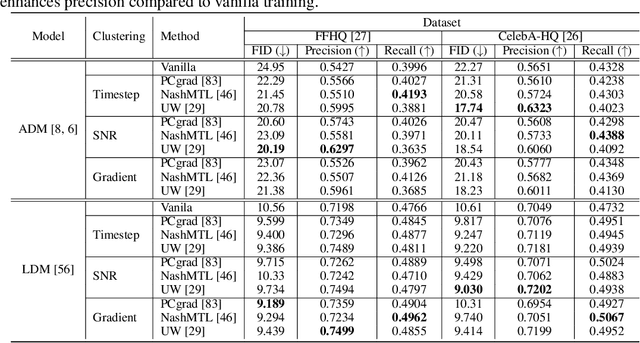
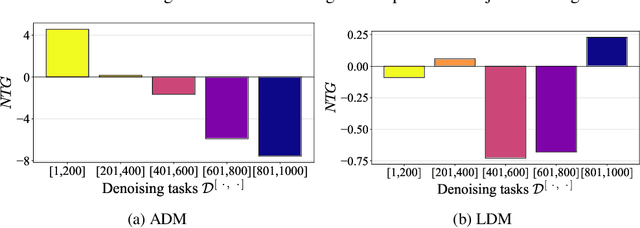

Abstract:Diffusion-based generative models have achieved remarkable success in various domains. It trains a model on denoising tasks that encompass different noise levels simultaneously, representing a form of multi-task learning (MTL). However, analyzing and improving diffusion models from an MTL perspective remains under-explored. In particular, MTL can sometimes lead to the well-known phenomenon of $\textit{negative transfer}$, which results in the performance degradation of certain tasks due to conflicts between tasks. In this paper, we aim to analyze diffusion training from an MTL standpoint, presenting two key observations: $\textbf{(O1)}$ the task affinity between denoising tasks diminishes as the gap between noise levels widens, and $\textbf{(O2)}$ negative transfer can arise even in the context of diffusion training. Building upon these observations, our objective is to enhance diffusion training by mitigating negative transfer. To achieve this, we propose leveraging existing MTL methods, but the presence of a huge number of denoising tasks makes this computationally expensive to calculate the necessary per-task loss or gradient. To address this challenge, we propose clustering the denoising tasks into small task clusters and applying MTL methods to them. Specifically, based on $\textbf{(O2)}$, we employ interval clustering to enforce temporal proximity among denoising tasks within clusters. We show that interval clustering can be solved with dynamic programming and utilize signal-to-noise ratio, timestep, and task affinity for clustering objectives. Through this, our approach addresses the issue of negative transfer in diffusion models by allowing for efficient computation of MTL methods. We validate the proposed clustering and its integration with MTL methods through various experiments, demonstrating improved sample quality of diffusion models.
Cross Encoding as Augmentation: Towards Effective Educational Text Classification
May 31, 2023
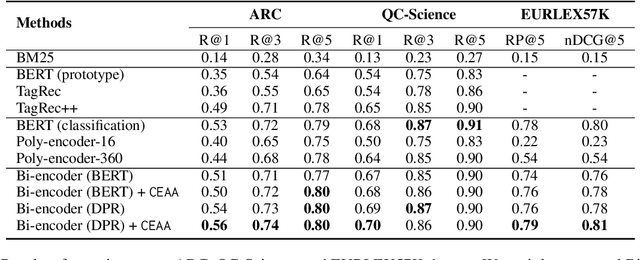
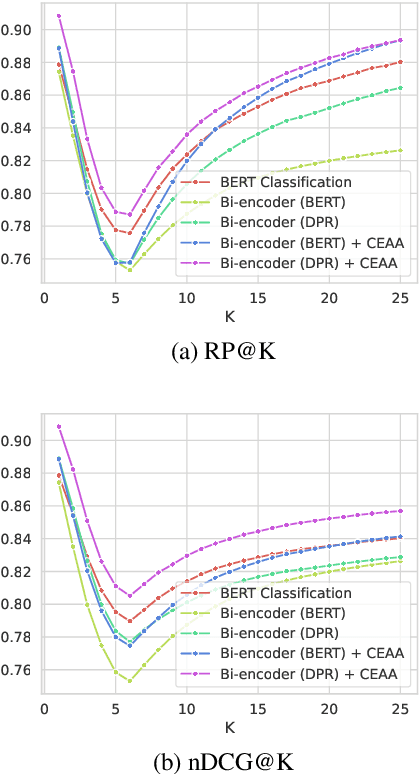
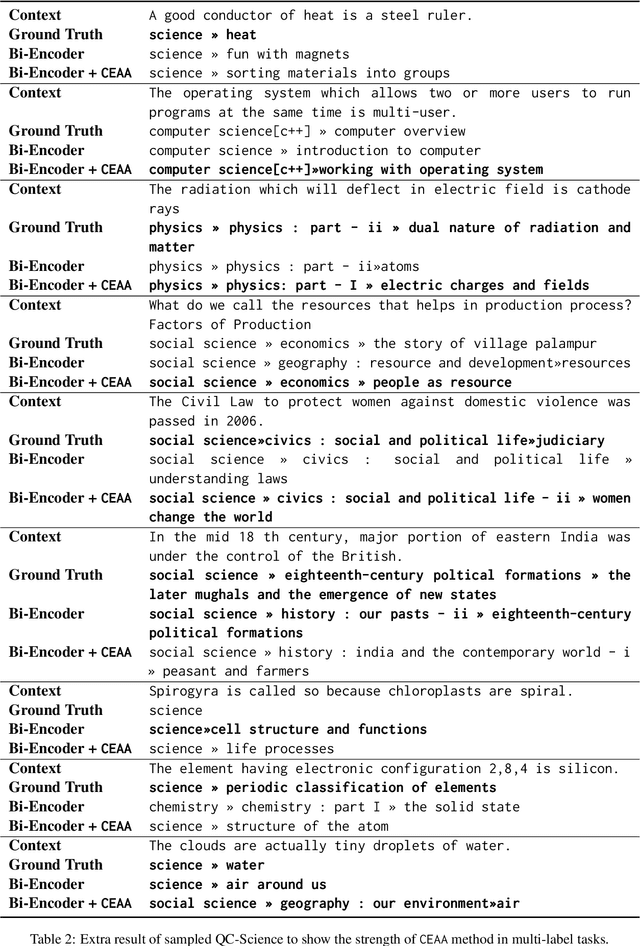
Abstract:Text classification in education, usually called auto-tagging, is the automated process of assigning relevant tags to educational content, such as questions and textbooks. However, auto-tagging suffers from a data scarcity problem, which stems from two major challenges: 1) it possesses a large tag space and 2) it is multi-label. Though a retrieval approach is reportedly good at low-resource scenarios, there have been fewer efforts to directly address the data scarcity problem. To mitigate these issues, here we propose a novel retrieval approach CEAA that provides effective learning in educational text classification. Our main contributions are as follows: 1) we leverage transfer learning from question-answering datasets, and 2) we propose a simple but effective data augmentation method introducing cross-encoder style texts to a bi-encoder architecture for more efficient inference. An extensive set of experiments shows that our proposed method is effective in multi-label scenarios and low-resource tags compared to state-of-the-art models.
Evaluation of Question Generation Needs More References
May 26, 2023Abstract:Question generation (QG) is the task of generating a valid and fluent question based on a given context and the target answer. According to various purposes, even given the same context, instructors can ask questions about different concepts, and even the same concept can be written in different ways. However, the evaluation for QG usually depends on single reference-based similarity metrics, such as n-gram-based metric or learned metric, which is not sufficient to fully evaluate the potential of QG methods. To this end, we propose to paraphrase the reference question for a more robust QG evaluation. Using large language models such as GPT-3, we created semantically and syntactically diverse questions, then adopt the simple aggregation of the popular evaluation metrics as the final scores. Through our experiments, we found that using multiple (pseudo) references is more effective for QG evaluation while showing a higher correlation with human evaluations than evaluation with a single reference.
Towards Practical Plug-and-Play Diffusion Models
Dec 12, 2022Abstract:Diffusion-based generative models have achieved remarkable success in image generation. Their guidance formulation allows an external model to plug-and-play control the generation process for various tasks without fine-tuning the diffusion model. However, the direct use of publicly available off-the-shelf models for guidance fails due to their poor performance on noisy inputs. For that, the existing practice is to fine-tune the guidance models with labeled data corrupted with noises. In this paper, we argue that this practice has limitations in two aspects: (1) performing on inputs with extremely various noises is too hard for a single model; (2) collecting labeled datasets hinders scaling up for various tasks. To tackle the limitations, we propose a novel strategy that leverages multiple experts where each expert is specialized in a particular noise range and guides the reverse process at its corresponding timesteps. However, as it is infeasible to manage multiple networks and utilize labeled data, we present a practical guidance framework termed Practical Plug-And-Play (PPAP), which leverages parameter-efficient fine-tuning and data-free knowledge transfer. We exhaustively conduct ImageNet class conditional generation experiments to show that our method can successfully guide diffusion with small trainable parameters and no labeled data. Finally, we show that image classifiers, depth estimators, and semantic segmentation models can guide publicly available GLIDE through our framework in a plug-and-play manner.
Towards Flexible Inductive Bias via Progressive Reparameterization Scheduling
Oct 04, 2022
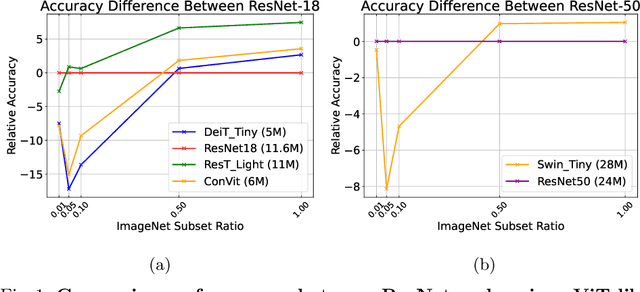
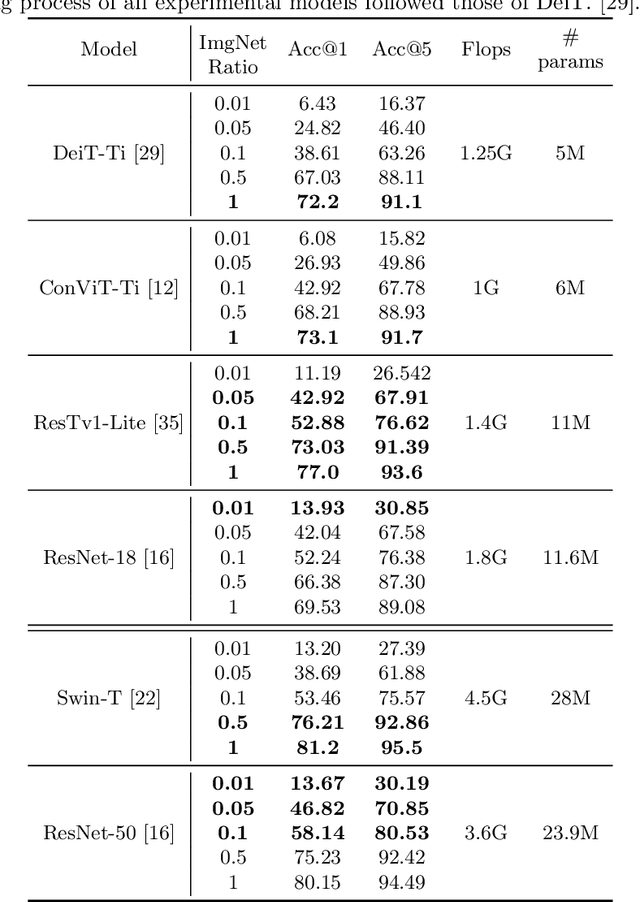
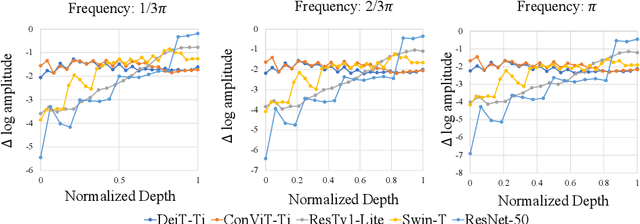
Abstract:There are two de facto standard architectures in recent computer vision: Convolutional Neural Networks (CNNs) and Vision Transformers (ViTs). Strong inductive biases of convolutions help the model learn sample effectively, but such strong biases also limit the upper bound of CNNs when sufficient data are available. On the contrary, ViT is inferior to CNNs for small data but superior for sufficient data. Recent approaches attempt to combine the strengths of these two architectures. However, we show these approaches overlook that the optimal inductive bias also changes according to the target data scale changes by comparing various models' accuracy on subsets of sampled ImageNet at different ratios. In addition, through Fourier analysis of feature maps, the model's response patterns according to signal frequency changes, we observe which inductive bias is advantageous for each data scale. The more convolution-like inductive bias is included in the model, the smaller the data scale is required where the ViT-like model outperforms the ResNet performance. To obtain a model with flexible inductive bias on the data scale, we show reparameterization can interpolate inductive bias between convolution and self-attention. By adjusting the number of epochs the model stays in the convolution, we show that reparameterization from convolution to self-attention interpolates the Fourier analysis pattern between CNNs and ViTs. Adapting these findings, we propose Progressive Reparameterization Scheduling (PRS), in which reparameterization adjusts the required amount of convolution-like or self-attention-like inductive bias per layer. For small-scale datasets, our PRS performs reparameterization from convolution to self-attention linearly faster at the late stage layer. PRS outperformed previous studies on the small-scale dataset, e.g., CIFAR-100.
HoughCL: Finding Better Positive Pairs in Dense Self-supervised Learning
Nov 21, 2021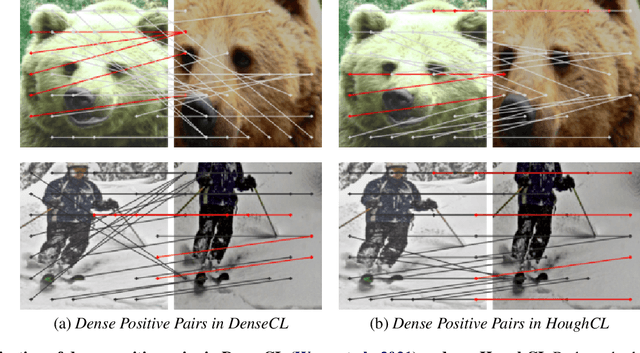
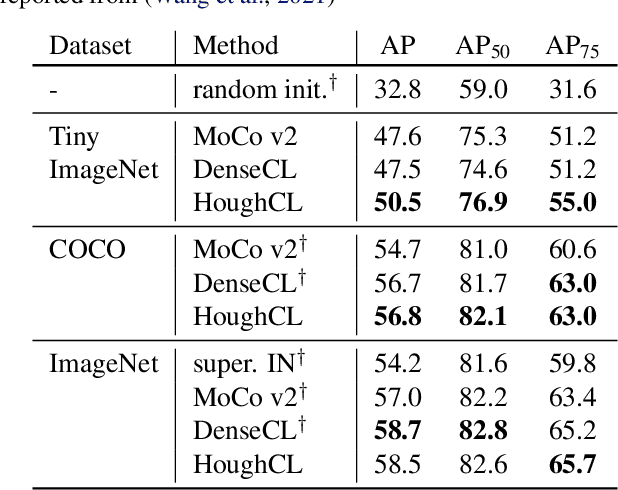
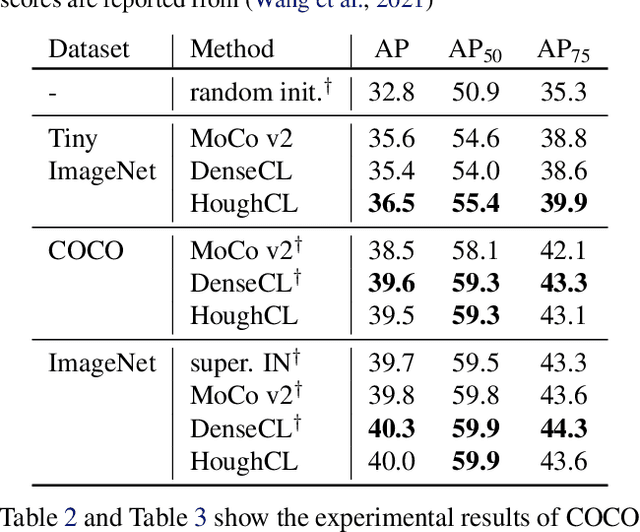
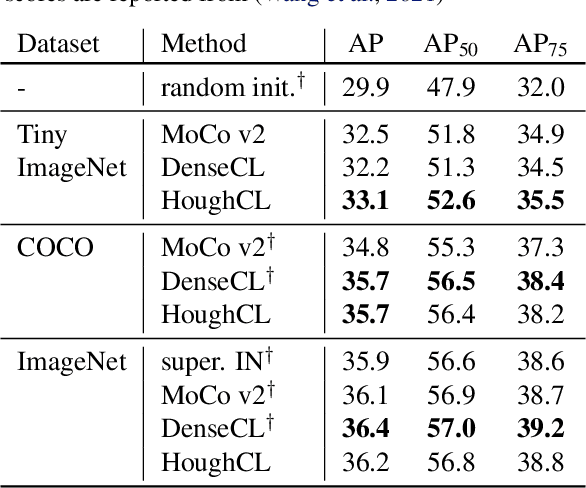
Abstract:Recently, self-supervised methods show remarkable achievements in image-level representation learning. Nevertheless, their image-level self-supervisions lead the learned representation to sub-optimal for dense prediction tasks, such as object detection, instance segmentation, etc. To tackle this issue, several recent self-supervised learning methods have extended image-level single embedding to pixel-level dense embeddings. Unlike image-level representation learning, due to the spatial deformation of augmentation, it is difficult to sample pixel-level positive pairs. Previous studies have sampled pixel-level positive pairs using the winner-takes-all among similarity or thresholding warped distance between dense embeddings. However, these naive methods can be struggled by background clutter and outliers problems. In this paper, we introduce Hough Contrastive Learning (HoughCL), a Hough space based method that enforces geometric consistency between two dense features. HoughCL achieves robustness against background clutter and outliers. Furthermore, compared to baseline, our dense positive pairing method has no additional learnable parameters and has a small extra computation cost. Compared to previous works, our method shows better or comparable performance on dense prediction fine-tuning tasks.
Semantic Correspondence with Transformers
Jun 04, 2021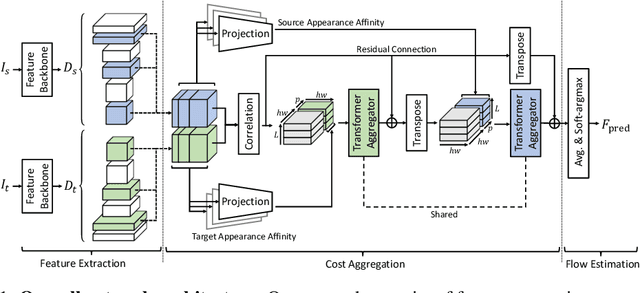
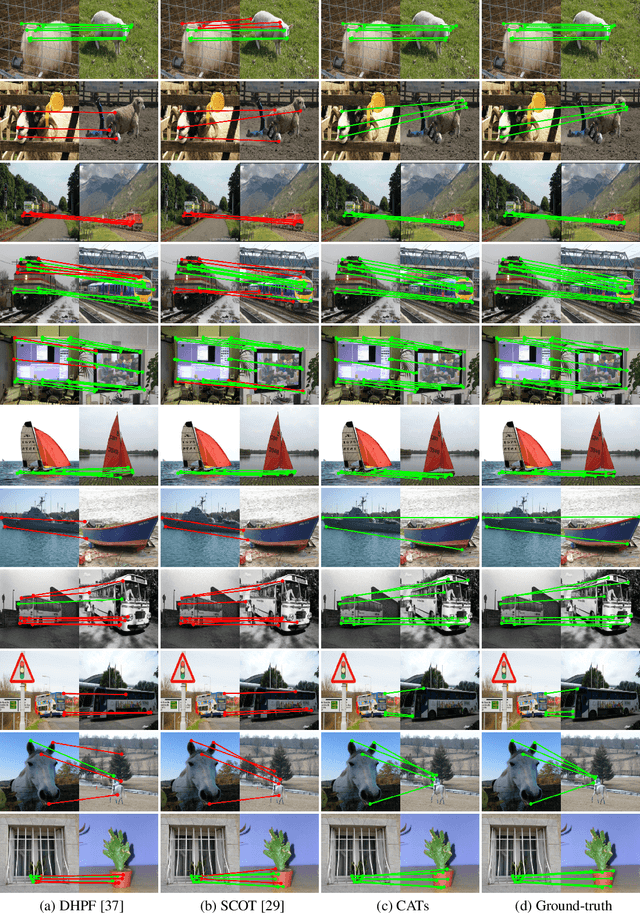

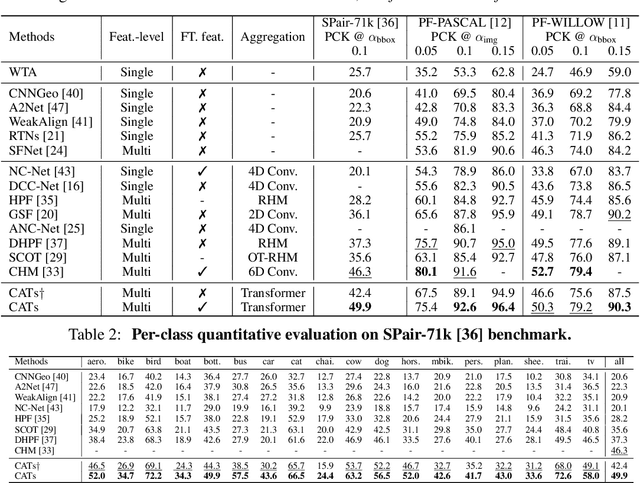
Abstract:We propose a novel cost aggregation network, called Cost Aggregation with Transformers (CATs), to find dense correspondences between semantically similar images with additional challenges posed by large intra-class appearance and geometric variations. Compared to previous hand-crafted or CNN-based methods addressing the cost aggregation stage, which either lack robustness to severe deformations or inherit the limitation of CNNs that fail to discriminate incorrect matches due to limited receptive fields, CATs explore global consensus among initial correlation map with the help of some architectural designs that allow us to exploit full potential of self-attention mechanism. Specifically, we include appearance affinity modelling to disambiguate the initial correlation maps and multi-level aggregation to benefit from hierarchical feature representations within Transformer-based aggregator, and combine with swapping self-attention and residual connections not only to enforce consistent matching, but also to ease the learning process. We conduct experiments to demonstrate the effectiveness of the proposed model over the latest methods and provide extensive ablation studies. Code and trained models will be made available at https://github.com/SunghwanHong/CATs.
Domain Generalization Needs Stochastic Weight Averaging for Robustness on Domain Shifts
Feb 17, 2021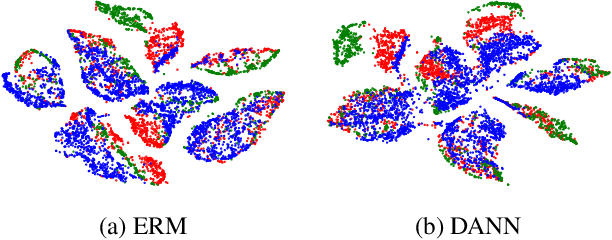
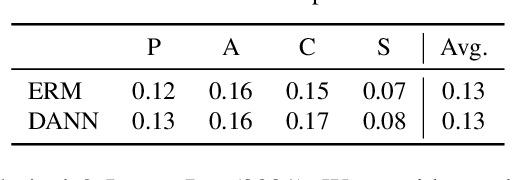
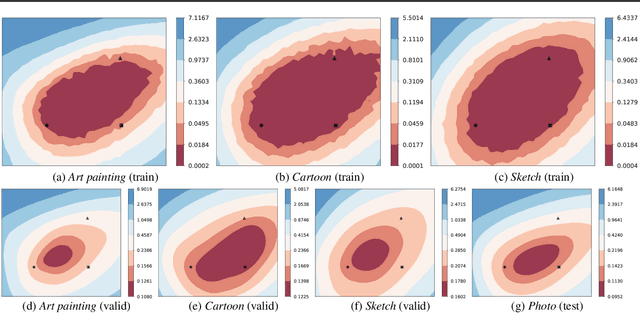
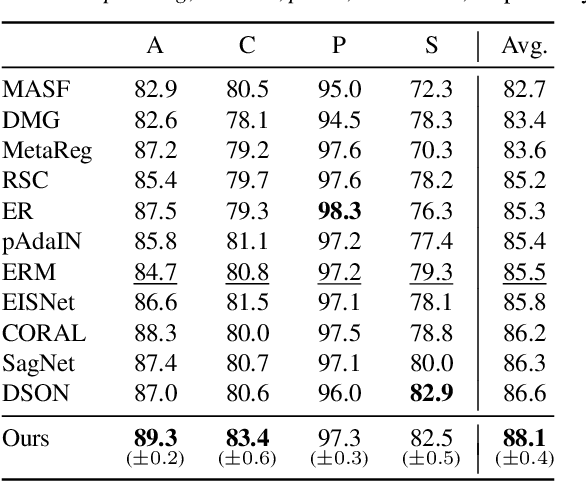
Abstract:Domain generalization aims to learn a generalizable model to unseen target domains from multiple source domains. Various approaches have been proposed to address this problem. However, recent benchmarks show that most of them do not provide significant improvements compared to the simple empirical risk minimization (ERM) in practical cases. In this paper, we analyze how ERM works in views of domain-invariant feature learning and domain-specific gradient normalization. In addition, we observe that ERM converges to a loss valley shared over multiple training domains and obtain an insight that a center of the valley generalizes better. To estimate the center, we employ stochastic weight averaging (SWA) and provide theoretical analysis describing how SWA supports the generalization bound for an unseen domain. As a result, we achieve state-of-the-art performances over all of widely used domain generalization benchmarks, namely PACS, VLCS, OfficeHome, TerraIncognita, and DomainNet with large margins. Further analysis reveals how SWA operates on domain generalization tasks.
 Add to Chrome
Add to Chrome Add to Firefox
Add to Firefox Add to Edge
Add to Edge